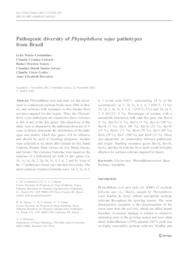Pathogenic diversity of Phytophthora sojae pathotypes from Brazil.
Pathogenic diversity of Phytophthora sojae pathotypes from Brazil.
Autoria: COSTAMILAN, L. M.; CLEBSCH, C. C.; SOARES, R. M.; SEIXAS, C. D. S.; GODOY, C. V.; DORRANCE, A. E.
Resumo: Phytophthora root and stem rot has developed in commercial soybean fields since 2006 in Brazil, and cultivars with resistance to this disease have not been targeted for this region. Thus, the Phytophthora sojae pathotypes are expected to have virulence to few if any of the Rps genes. The objectives of this study were to characterize the pathotype diversity of P. sojae in Brazil, determine the distribution of the pathogen and predict which Rps genes will be effective andshouldbeusedinbreedingprograms.Isolates were collected in six states (Rio Grande do Sul, Santa Catarina, Paraná, Mato Grosso do Sul, Minas Gerais, and Goiás). The virulence formulae were based on the response of a differential set with 14 Rps genes (1a, 1b, 1c, 1d, 1k, 2, 3a, 3b, 3c, 4, 5, 6, 7, and 8). None of the 17 pathotypes found was reported previously. The most common virulence formulas were: 1d, 2, 3c, 4, 5,6, 7 (octal code 05471, representing 24 % of the occurrences); 1d, 2, 3b, 3c, 4, 5, 6, 7 (05671, 13 %); 1b, 1d, 2, 3a, 3c, 4, 5, 6, 7 (25571, 8 %); and 1d, 3a, 5,7, 8 (01123, 8 %). Percentages of isolates with a susceptible interaction with each Rps gene was Rps1a (3 %), Rps1b (11 %), Rps1c (3 %), Rps1d (100 %), Rps1k (3 %), Rps2(86%),Rps3a (32 %), Rps3b (19 %), Rps3c (73 %), Rps4 (70 %), Rps5 (89 %), Rps6 (59 %), Rps7 (100 %), and Rps8 (22 %). There was apparently no relationship between pathotypes and origin. Stacking resistance genes Rps1a, Rps1b, Rps1c, and Rps1k with Rps3b or Rps8 would be highly effective for soybean cultivars targeted for Brazil.
Ano de publicação: 2013
Tipo de publicação: Artigo de periódico
Unidade: Embrapa Trigo
Palavras-chave: Doença de planta, Glycine Max, Phytophthora root rot, Race, Soja, Soybean
Observações
1 - Por padrão são exibidas publicações dos últimos 20 anos. Para encontrar publicações mais antigas, configure o filtro ano de publicação, colocando o ano a partir do qual você deseja encontrar publicações. O filtro está na coluna da esquerda na busca acima.
2 - Para ler algumas publicações da Embrapa (apenas as que estão em formato ePub), é necessário ter, no celular ou computador, um desses softwares gratuitos. Sistemas Android: Google Play Livros; IOS: iBooks; Windows e Linux: software Calibre.
Acesse outras publicações
Acesse a Base de Dados da Pesquisa Agropecuária (BDPA) para consultar o acervo completo das bibliotecas da Embrapa.

